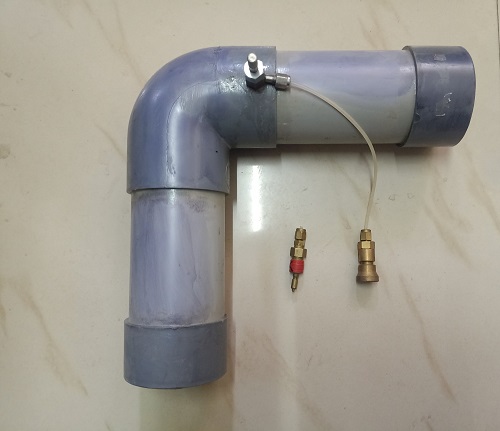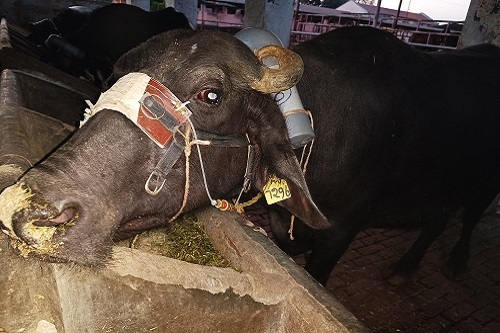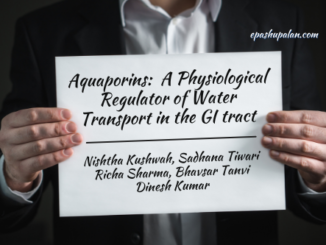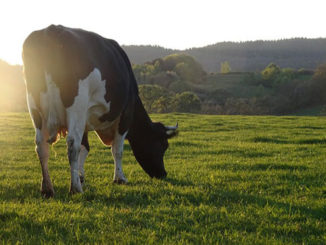Abstract
A commonly used method of measuring enteric methane (CH4) emissions from ruminants is the SF6 tracer technique that measures respired and eructated CH4. However, within the animal, a small proportion of CH4 is produced post-ruminally and some of this may escape through the rectum. The comparison of emissions using a chamber technique that measures all enteric CH4 losses, and the SF6 tracer technique, could give some insight into the magnitude of post-ruminal emission. The tracer technique enables estimation of methane emissions from large numbers of individual ruminant and pseudo-ruminant animals without the need for their confinement.
Key words: Ruminant, Methane Emission, Sulfur hexafluoride
Introduction
Ruminants are mainly fed on lignocellulosic agricultural by-products like cereal straws, stover, sugarcane bagasse etc. The rumen microbes convert these un-utilizable plant tissues into valuable animal products like meat and milk. The rumen microbial ecosystem is highly diversified which comprises bacteria, protozoa, fungi, and bacteriophages. Unfortunately, fermentation in the rumen is associated with various losses because of the fermentation of different nutrients like carbohydrate (structural and non- structural) and protein. CO2, methane and ammonia are the metabolic end products which are wasteful as far as the nutrition of animal is concerned but they are unavoidable products of rumen fermentation. During rumen fermentation, the methane production leads to 2-15% of loss in the GE (Moss et al., 2000; Holter and Young, 1992). Domestic livestock since long has been blamed for substantial contribution to global anthropogenic GHG emissions. The world population of domesticated ruminants is thought to be responsible for 29% of total CH4 emissions due to anaerobic enteric fermentation of feeds. The contribution of India’s livestock to global methane emissions is 10.63%. Also, methane is a potent greenhouse gas having 23 times more global warming potential than CO2, enteric methane production contributes significantly to global warming. Considering the detrimental effects of these gases, the measurement of their emissions from ruminants is an important aspect from environmental point of view.
The emission of enteric methane from ruminants can be estimated using a calibrated tracer technique developed by Zimmerman (1993) and first deployed by Johnson et al. (1994). The tracer technique enables estimation of methane emissions from large numbers of individual ruminant and pseudo-ruminant animals without the need for their confinement.
The SF6 tracer technique relies on a known source of a synthetic inert tracer – sulphur hexafluoride (SF6) – inserted in the rumen, where at least 90% of CH4 is sourced. ‘Breath’, characterized as respired plus eructed gases, is sampled and analyzed. This technique can be used with untethered, freely-grazing animals. Moreover, the equipment cost per animal under test is much lower than for chamber experiments, enabling dozens or even hundreds of animals to be breath-tested in a single experiment.
Principle
SF6 gas mixes with CH4 and other gases present in the rumen and continuously comes out along with them. Gas collection assembly collects fraction of gases emitted by nose and mouth continuously for 24 hr. Total amount of CH4 produced “during 24 hr is calculated by estimation of CH4 and SF6 concentration in the total collected gases.
Requirements
- Permeation tube
- Pure SF6 gas
- Canister
- Halter
- GLC system and Standards of CH4 and SF6
Permeation tube
It is 2-3 inches long tube made up of brass and having a screw cap with teflon disc & frit of 2 µ pore size.
Canister
It is made up of PV tube having air tight valve which is evacuated with the help of vacuum pump and the pressure is recorded.
Halter
It is made up of strips which can be fitted on the mouth of animal along with gas collection assembly.
Gas collection assembly
Contains a filter connected with very fine capillary. The suction rate can be adjusted by the length of capillary tube. If capillary tube is small, suction rate is high and vice versa. It should be adjusted in such a way that half of canister is filled in 24 hr.
Background
An evacuated PVC canister (background) is placed where animals are kept, to measure ambient CH4 and SF6. (Fig: 1)

Procedure
- Preparation of permeation tube
Pure SF6 gas is filled in permeation tube by cooling it with the help of liquid nitrogen. About 150 ml (1 g) of SF6 gas is added and closed tightly (Lassey et al., 2011). Tube is weighed before and after putting the gas to know weight of SF6. Keep at 39±10C water bath. Daily weight of permeation tube is taken to know the release rate of SF6 gas. It takes 20-25 days to get established release of SF6.
A requirement of the technique is the release of a tracer gas (sulphur hexafluoride, SF6) at a known constant rate into the reticulo-rumen of each animal. To achieve this, a slow-release device, known as a permeation tube, is placed in the reticulo-rumen (Zimmerman, 1993). The subsequent pattern of SF6 emission from a ruminant animal has not been reported. However, it is well known that the rate of methane emission from ruminants can vary considerably throughout the day in relation to feeding (Machmüller and Hegarty, 2006.). Thus, the SF6 technique requires a representative sample of emitted gases to be collected at a constant rate to ensure that an equal proportion of the sample is collected throughout the typically 24 h sampling period. (Fig: 2)

- Collection of sample
The permeation tube is inserted into the rumen of animal 2 days before collection period with the help of rubber tube or drenching pipe. Gas collection assemble is put on the animal. Evacuated canister is attached (McGinn et al., 2006). After 24 hr, remove the canister and note down the pressure (upto – 6 or – 7). Then bring it to positive pressure upto +1 to +2 with liquid nitrogen.
- Analysis
The concentration of SF6 in the canisters was analyzed by gas chromatography, fitted with an electron capture detector (250°C) to determine SF6 and 3.3 m molecular sieve column with an i.d. of 0.32mm. Another gas chromatograph was fitted with a flame ionization detector (100°C) and stainless steel column packed with Porapak-Q to determine CH4 concentration (Dlugokencky et al., 2011). The column and injector temperatures were 50 and 40°C in both gas chromatographs. All samples were analyzed in duplicate except standards, which were analyzed in triplicate. Nitrogen was used as the carrier gas at a pressure of 1kg/cm2 (Grainger et al., 2007). The standards were run at the beginning and end of each day with the medium standard run every 10 samples throughout the day. Gas concentrations (SF6 and CH4) were determined from peak areas and identified from their different retention times relative to the known standards.
The methane output calculated using following formula:
Q CH4 (mg/d) = Q SF6 × [(CH4)s – (CH4)b]/ [(SF6)s– (SF6)b]
Where
QSF6 – Release rate of SF6 (mg/d)
(CH4)s and (CH4)b – Methane concentrations in sample canister and background’s canisters (ppm),
(SF6)s and (SF6)b – Concentrations of SF6 in sample canister and background’s canisters (ppm).
Advantages
- It’s highly precise and accurate method
- This technique eliminates the necessity to restrain or enclose the animal, thus allowing the animal to move about and graze.
- It is also not necessary to sample directly from the animal’s rumen or throat because the use of the tracer accounts changes in dilution associated with head or air movement.
- It gives good estimates of the between animal and within animal variation in emissions and is also well suited for comparison of distinct mitigation strategies.
- The residual variation on measurements is higher than with the chamber method, but it is possible to employ more animals per experiment, which provides a better statistical foundation for testing hypotheses.
Disadvantages
- SF6 procedure has been used for large-scale genetic and nutritional evaluations, it remains labour intensive, expensive and dependent on technical specialists for operation and analysis.
- SF6 is a greenhouse gases itself, with a GWP 23,900 times that of CO2 and an atmospheric lifetime of 3,200 years.
- The residue of SF6 in meat and milk from farm animals is another issue.
- It is necessary to train the animal to wear a halter and collection yoke/canister.
References
- Dlugokencky, E.J., Nisbet, E.G. Fisher, R. and Lowry. D. 2011. Global atmospheric methane: budget, changes and dangers. Philosophical Transactions of the Royal Society A: Mathematical, Physical and Engineering Sciences 369(1943):2058-2072.
- Grainger, C., Clarke, T., McGinn, S. M., Auldist, M. J., Beauchemin, K. A., Hannah, M. C., Waghorn, G. C., Clark, H. and Eckard, R. J. 2007. Methane emissions from dairy cows measured using the sulfur hexafluoride (SF6) tracer and chamber techniques. J. Dairy Sci. 90(6):2755-2766.
- Holter, J. B. and Young, A. J. 1992. Methane Production in Dry and Lactating Holstein Cows. J. Dairy Sci. 75: 2165-2175.
- Johnson, K., Huyler, M., Westberg, H., Lamb, B. and Zimmerman, P. 1994. Measurement of methane emissions from ruminant livestock using a SF6 tracertechnique. Environ. Sci. Technol. 28, 359–362.
- Lassey, K. R., Pinares-Patiño, C. S., Martin, R.J, Molano, G. and McMillan, A. M. S. 2011. Enteric methane emission rates determined by the SF6 tracer technique: temporal patterns and averaging periods. Anim. Feed Sci. Tech. 166–167, 183-191.
- Machmüller, A., and Hegarty, R.S. 2006. Alternative tracer gases for the ERUCT technique to estimate methane emission from grazing animals. Int’l. Congress Series. 1293, 50-53.
- McGinn, S. M., Beauchemin, K. A., Iwaasa, A.D. and McAllister, T.A. 2006. Assessment of the sulphur hexafluoride (SF6) tracer technique for measuring enteric methane emissions from cattle. J. Environ. Qual. 35: 1686-1691.
- Moss, A. R., Jouany, J. P. and Newbold, C. J. 2000. Methane production by ruminants: its contribution to global warming. Ann. Zoo technol. 49: 231-235.






Be the first to comment